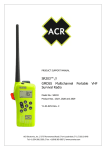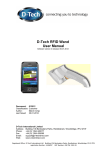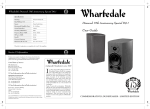Download C-SCOPE XD Instruction manual
Transcript
Instruction Manual Cable Avoidance Tool Cable Avoidance Tool XD Signal Generator SG-A Signal Generator SG-V CABLE AVOIDANCE TOOLS WARNINGS The C.Scope Cable Avoidance Tools locate services radiating a detectable field. There may be some services that do not radiate and cannot be located. ALWAYS EXCAVATE WITH CARE Do not use the equipment outside of the temperature range -10˚C to +50˚C as the batteries may cease to function adequately. Geographical conditions such as hills and mountains can effectively screen radio signals and prevent a detectable ground current. The C.Scope Cable Avoidance Tool alone will not always locate every conductor so always use a Signal Generator. The C.Scope Signal Generator leads must not be connected directly to a live service. System performance may be impaired by unusually strong electromagnetic fields. Beware of multiple services. The C.Scope Cable Avoidance Tool will not always indicate close services, either side by side or one above the other. Do not use the equipment in areas where hazardous gases may be present. Check for underground services before using the earth stake. Copyright © 2004 C.Scope International Ltd. All Rights Reserved. C.Scope International Ltd make every effort to ensure that the information we provide about our products and their use is correct. We do not accept responsibility for injury, damage, or consequential loss arising from the use of our products. Local, national and international requirements and regulations must take preference. Contents Warnings Inside Front Cover Features Using the Signal Generator 12 Batteries 13 Cable Avoidance Tool (and XD Model) 1 Direct connection 14 Signal Generator (SG-A and SG-V Models) 2 Street lighting 16 Locator Operating Modes Signal Clamp/ Injector 17 Power 4 Searching 18 Radio 5 Tracing 19 Generator 6 Using the Locator Induction 20 Searching 21 Batteries 7 Multiple Services 23 Holding the Locator 8 Inductive Sweep 24 Searching 9 Non-Metallic Pipe Tracing 25 Pinpointing 10 Sonde 26 Tracing 11 Plastic Pipe Tracer 28 Depth Measurement Sonde/ Plastic Pipe Tracer 30 32 Function checks 33 Maintenance 37 Specifications Cable Avoidance Tool Signal Generator Support Services 38 39 40 The C.Scope Cable Avoidance Tool (And XD Model) Digital display Digital display Depth measurement button (XD model only) Mode selected: Generator (showing frequency) Power Radio Detachable loud speaker On/ Off switch Sensitivity control 3 position mode switch Depth display (XD Model only) 1 Battery compartment Signal strength bar display Replaceable wear foot Battery condition indicator The C.Scope Signal Generator (SG-A and SG-V Models) Digital display (SG-V only) On/Off switch Battery condition indicator Mute/loud setting Loud/Mute switch Power output level indicator Pulsed/Continuous output switch Induced or connected mode indicator High power switch Signal strength bar display Low power switch Batteries Direct connection socket Auxiliary earth lead socket Accessory tray 2 The C.Scope Signal Generator (SG-A and SG-V Models) Accessory tray Accessory tray holding clips Earth stake Direct connection leads Crocodile clips Auxiliary 10m earth lead Connection magnet 3 Locator Operating Modes: Power Mode In Power Mode the locator detects power signals. These power signals are present on all current carrying electricity cables although not all are detectable. These power signals may also flow along other buried conductors such as metal gas and water pipes. Limitations of Power Mode Not all electricity cables can be found using the Power mode. Here are the most important examples of electricity cables that may not be detectable in the Power mode: ● ● ● ● ● Street lighting cables. When the lights are off, no current flows and so no power signal is created. Supplies to buildings or plant using very little or no electricity will not have a detectable power signal. Pot-ended or capped cables. These will never have any current flowing through them but are possibly still live. Disused or abandoned cables. A few high voltage electricity cables. These can be “well balanced”, electrically and therefore radiate little or no Power signal. ● Direct current cables (such as those found on railway systems). These do not create their own Power signals. ● Cables more than 3 metres deep. WARNING Locators can only detect services radiating a detectable electromagnetic signal. There may be some services that do not radiate these signals and cannot be located. WARNING Absence of Power signal does not mean the service is not live. NOTE Generally these services should be detectable using the Radio or Generator modes. 4 Locator Operating Modes: Radio Mode In Radio mode, the locator detects signals from radio transmitters. These signals flow through the ground and will tend to follow the line of least resistance such as a buried metallic service. When this happens the service can often be detected by using the locator in Radio mode. Limitations of Radio Mode ● Not all services will be detectable in Radio mode. ● A strong Radio signal present on one service may be masking a weaker Radio signal present on an adjacent service. ● It is not normally possible to determine WHAT the service is in Radio mode, only it’s position. ● Radio signals do not favour one utility over another. ● The depth of the buried service CANNOT be judged by the strength of the radio signal alone. ● Normally it is only possible to detect Radio signals present on services up to 2 metres deep. ● A short service may not have enough signal to be detected. WARNING Locators can only detect services radiating a detectable electromagnetic signal. There may be some services that do not radiate these signals and cannot be located. NOTE Most buried metallic services not found in Radio mode should be detectable by using Generator mode with a Signal Generator. 5 Locator Operating Modes: Generator Mode In Generator mode the locator detects conductors radiating a signal applied by the Signal Generator. The Signal Generator provides a way of sending a known signal along buried metallic services which can then be detected using the locator. Direct Connection By detecting this signal it is possible to locate, trace and identify the pipes or cables that may be carrying it. There are TWO basic methods by which the Signal Generator signal can be applied to buried services: Direct Connection - The Signal Generator is attached directly to the service using either the Direct Connection Leads or one of the accessories available for use with the Signal Generator such as the Signal Clamp of Signal Injector. Induction Induction - The Signal Generator can induce a signal onto a buried metallic service remotely from the surface without the need to physically connect to that service. Limitations of Generator Mode are covered in Using the ‘Signal Generator’ section of this manual. WARNING Locators can only detect services radiating a detectable electromagnetic signal. There may be some services that do not radiate these signals and cannot be located. 6 Using the Locator: Batteries Locator Battery Check Switch the locator on by pulling up on the On/Off trigger positioned on the underside of the handle. The locator should emit a clear audible battery check tone for one second and the display should come on. Battery levels Check the battery level indicator in the bottom left hand corner of the display. If there is only one segment or no segments of the indicator filled in then the batteries will need to be renewed before locating work can begin. Changing Locator Batteries Push the two clips back to release the battery compartment door. Remove ALL EIGHT used batteries and replace with new ones. Be careful to insert the new batteries the correct way round in the holder. Replace the holder in the battery compartment making sure that the two terminals on the holder make contact with the two terminals within the battery compartment. Close the battery compartment door securely. NOTE Only use alkaline AA (LR6) size batteries. Dispose of the used batteries safely in accordance with local regulations. WARNING Do not change batteries in confined spaces where gas may be present. 7 Using the Locator: Holding the Locator When in use the locator should always be held upright. NEVER swing the locator such that it moves away from the vertical. Your middle or little finger should be used to squeeze, and hold on, the On/Off trigger. Your index finger will then be free to adjust the sensitivity control. 8 Using the Locator: Searching There are three stages to the locating process; searching, pinpointing and tracing 1. Turn the function switch to the appropriate mode 2. Hold in the On/Off trigger. The locator should emit the audible battery test tone and the digital display should come on. Check the battery level indicator to confirm the batteries are usable. 3. Rotate the Sensitivity control clockwise to its maximum setting as indicated by the arrow on the control. 4. Carry out the search using a grid pattern as shown in the diagram. Walk slowly and keep the locator upright at all times and stationary by your side. 5. As you approach the area in which there is a signal the locator will emit an audible response and show a visual response on the bar display. 6. Keep walking until the audible and visual responses disappear. NOTE This search technique applies only to the Power and Radio modes. See ‘Using the Signal Generator’ for the correct search pattern when using Generator mode. NOTE Sometimes the locator will give an audible response and strong (full scale) visual response across the whole of the search area. In this case turn the sensitivity down slightly and repeat the search using the same grid pattern. 9 Using the Locator: Pinpointing Having found the presence of a signal the next stop is to pinpoint the source. The closer the locator is to the signal source the stronger the response. To Pinpoint a Signal 1. Keeping the locator vertical, walk through the area of the signal response. If the visual response goes off the scale then stop, reduce the sensitivity of the locator slightly before continuing. 2. The width of the signal response will begin to shrink as the sensitivity is reduced. Once the sensitivity is reduced enough then a clear peak response will be seen on the bar display as the locator traverses the service. The locator is positioned directly above the buried service when the bar display is at its highest (peak) reading. 3. Carefully rotate the locator over the peak reading until the visual response falls to a minimum level. The locator will now be roughly IN LINE with the direction of the buried service. 4. Mark the position of the buried service. NOTE The amount of sensitivity adjustment needed to pinpoint a service can vary depending on the mode being used, the signal strength and the service depth. 10 Using the Locator: Tracing Having pinpointed a service it should now be possible to trace it’s route. 1. Carefully follow the direction of the signal holding the locator at right angles to the line of the signal. It is necessary to constantly ‘slice’ the locator from side to side in order to be sure of still being over the peak signal response. 2. Stop and mark the position of the signal at regular intervals. As more marks are recorded the precise direction of the service will become more apparent. NOTE It may be necessary to readjust the sensitivity to maintain the optimum response. NOTE After tracing return to the original search grid to search for further buried services. WARNING Never rush the tracing process. Small and unexpected changes in the service’s route will be missed if care is not taken to follow the signal’s path every step of the way. Lost Signals This can be because of a curve, or bend in the route, change in depth of the service, a T connection or the end of the service. Finding Lost Signals 1. Locate in a circle at least 1metre around the point where the signal was lost. This should locate the service if it has simply changed direction sharply or ‘T’d’ into another service. 2. If you find nothing then increase the sensitivity and repeat the circle. This should find the service if it has continued but at a greater depth. 11























